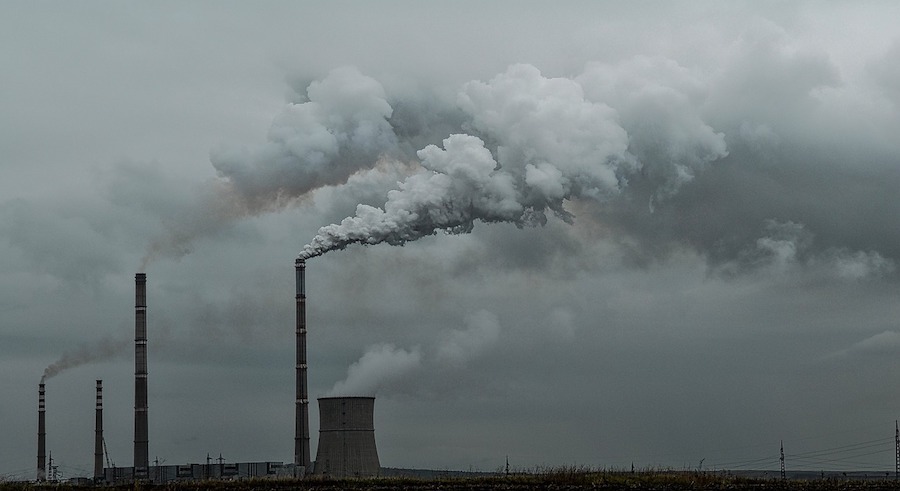In this piece, Enno Schröder and Servaas Storm offer a reply to Michael Grubb’s response to their paper, on the incompatibility of sustained levels of economic growth with decarbonization.
We are grateful to Michael Grubb for the way he has engaged, in a critical but constructive manner, with our approach and conclusions. His commentary, which shows a close reading of what we argued, should be read (we feel) as mostly complementary to our analysis—Professor Grubb adds important evolutionary dynamics (in the form of logistic substitution) to our macro accounting identities and the rather “black-box” Carbon Kuznets Curve (CKC).
We accept his main point that processes of change can be, and often are, non-linear and accelerating—which are not explicitly captured by extrapolating change based on constant average annual growth. Grubb highlights notable examples of carbon-decoupling in recent times, including his “own” U.K. as well as the EU and the U.S. (in Figure 3)—and argues that what is still limited progress now can quickly accelerate (in cumulative fashion) into more substantive and possibly even revolutionary change. The question then becomes how the technical advance can be scaled up from a “niche” phenomenon to an economy-wide process, which, in Grubb’s understanding, is a more limited task than trying to overhaul the complete energy system in one big sweep. It forms the basis of his “conditional optimism” that we can still bring about the deep decarbonization needed to keep global warming below 1.5 °C. While we agree on most issues and on the need to keep warming below the 1.5 °C threshold and while we certainly welcome Grubb’s plea for “historical future” analysis, there are still five areas where we think we have not made ourselves clear enough and/or where we have been misunderstood.
The first area concerns the purpose of our analysis. We used historical data—in our Kaya identity analysis[1] and in our CKC analysis—to assess how much decarbonization has already happened. The answer is zilch. Our Kaya identity-based projection for the period 2050, which is based “official” and highly optimistic Intergovernmental Panel on Climate Change (IPCC) and International Energy Agency (IEA) projections for deep decarbonization and energy efficiency improvements (supposedly consistent with the IPCC warming targets), suggests that climate-constrained global growth is approximately zero. That we are seen as being too pessimistic is actually a bit surprising in view of the historically unprecedented (and empirically unwarranted) decarbonization we are assuming to occur in the next 32 years. Our CKC analysis for 61 (mostly high-income) countries shows, finally, that there is no decoupling between growth and consumption-based carbon emissions. All this leads us to conclude that the future must be radically different from the past (as we write and Professor Grubb is also insisting) and that we are only deceiving ourselves if we think that we can prevent dangerous climate change by small changes from business-as-usual.
This brings us to the second area of disagreement. Professor Grubb is right to point out the relevance of logistic growth models to describe the increases in renewable energy penetration, but that does not diminish the relevance of using a period-average annual growth rate (as we do in our Kaya-identity projection). Depending on the choice of parameters, the market share growth of renewables may take longer than is now indicated in his graph—and if it takes longer than we likely exceed the carbon budget that is consistent with non-dangerous warming. One could even argue against the appropriateness of logistic growth: if it is true that the renewables energy penetration which has so far occurred, has happened in areas where it was relatively easy to do so and low cost (this is the “low hanging fruit’ argument”), then there may be reasons to expect it to be more difficult to step up the share of renewables in the energy mix from 20% to 40% than to increase it from 0 to 20%. Reasons for this could be the problem of increasing intermittency, the lack of fully developed energy storage systems, and the suitability of low-carbon backstop electricity generators. Market share growth may appear to be following a logistic curve in the initial stage, but this could be misleading—and growth could turn “linear” in later stages. This has nothing to do with optimism or pessimism—it concerns a fundamental known unknown.
A third area of difference concerns Grubb’s examples of cases where a decoupling of economic growth and carbon emissions has actually occurred. Grubb highlights the experience of his own U.K. which has managed to reduce its CO2 emissions by about 45% since 2000. But this is a reduction in territorial emissions; the U.K., which runs a trade deficit, is a net carbon importer—and its consumption-based emissions in 2015 are 44% higher than its territorial emissions.[2] So it is true that there is (relative) decoupling, but less so than what Grubb is suggesting.
The fall in carbon emissions in the U.K. is mostly due to gas replacing coal in the energy system, as Grubb explains; this roughly halves emissions but does not reduce them to zero. Grubb’s Figure 3.b shows a sharp decline in the consumption-based emissions of the U.S. economy as well. This decoupling started after 2008, and its main driver of this has been the shale gas revolution (or devastation, if one prefers) which raises gas supply and reduces gas prices. U.S. electricity producers abandoned coal and now use gas. The problem here is that shale gas production is economically viable only at the historically very low interest rates of the post-2008 period. Higher interest rates will bankrupt shale gas producers—a process which has already begun.[3] Accordingly, as soon as the U.S. interest rates go back to more normal (higher) levels, the shale gas companies are likely to go bust—gas prices will rise and electricity generators may change back to coal, undoing the temporary (relative) decoupling between growth and carbon emissions. In more general terms, we don’t think that it will be easy to scale up and sustain the initial (and still limited) “successes” of de-carbonization.
A fourth area of divergence concerns policy. Grubb writes that “the greatest case for pessimism lies in systematic failures of policy” and we wholeheartedly agree. But he then does not discuss why policy is systematically failing. We suggest, as we did in the paper, that one factor contributing to systematic policy failure is the vested interests against decarbonization of oil and mining companies, fossil-fuel electricity producers, and the automotive industry, as well as of finance and financial investors. There is clear evidence that the fossil-fuel industry has been actively spreading climate-change scepticism (and denial), as it wants to protect its shareholders from having to write off most their assets.[4] It is at the same time true, as shown by IMF estimates for 2015, that the global fossil-fuel sector is the (direct and indirect) recipient of around $5.3 trillion in annual subsidies, which amounts to 6.5% of global GDP.[5] The presence of these powerful interests, and their political money, has to be a major “condition” on any optimism.
Our final concern has to do with Professor Grubb’s use of Paul Romer’s metaphor of a child hoping to build a tree hut. The metaphor correctly stresses human agency, novelty and creativity, and reminds us of how we can be hopeful in situations in which we have to develop the knowledge, skills and experience, in a process of learning by doing, of how to build the treehouse. But the metaphor is wrong. The difference with our current situation is this. We must in fact tell the child that they have 12 days to build the treehouse; a hurricane is coming and if the hut is not ready, the hurricane will certainly destroy it. Luckily the child gets the help of two mainstream economists. The first one is William Nordhaus. Nordhaus will instruct the child that they have to be parsimonious and save so as to build up enough wealth in the next two or three decades to be able to buy better equipment at a lower cost relative to income than today. There’s no rush, the optimal strategy is to slowly ramp up the building activity. The tree will have died because of warming in the meantime, but then who cares—the child will have enough wealth in the future to compensate for the loss.
Then enter Paul Romer who instructs the child that they have to first improve the equipment by R&D and innovation; the current saw, hammer etc. are not good enough. However, because the child is going slowly, building the treehouse gets incentivized. The child is promised a visit to Disney World if they manage to innovate faster. The child starts to make progress with the improved equipment, but then needs an innovative glue to repair their hammer. Unfortunately the glue is expensive because of patent protection, so the child applies for a subsidy to fund the expense. This process continues, but then the hurricane comes and blows away whatever has been built…
The point is that neither intertemporal utility maximization by a benevolent and almighty macro-planner nor micro-level incentivization based on prices or subsidies will be effective in getting carbon emissions down to zero by 2050.
This again is our point: the future has to be different, including a different approach to policy. Radical change within a limited time span is what we need—and this needs collective action and a strong directional thrust which “markets” or “private agents” alone are unable to provide. Unlike Grubb, we think that markets will not be capable of selecting, fostering and (leave alone!) funding the necessary technological advance within the time frame needed.
Where does this leaves us? To us, Professor Grubb’s conditional optimism looks like a triumph of hope over experience. What we need is not hope, but realism. The reality is that deforestation is on the rise: 7,900 square km were deforested in Brazil between August 2017 and July 2018, which is the highest rate of deforestation in Brazil in a decade.[6] The reality is that global carbon emissions will rise to a new record level in 2018. “This makes the chances of reaching a target to keep temperature increases to 1.5 or 2°C remote,” Fatih Birol, the head of the IEA told Reuters on October 16.[7] He added that “My numbers are giving me some despair.” We agree with Michael Grubb that his is the wrong response. But we don’t need conditional optimism. We need to act, now—and in ways which are first and foremost effective (rather than “efficient”).
[1] A formula for an identity-decomposition introduced by the Japanese researcher of the same name: Carbon emissions (per year) = Population x (GDP per person) X (carbon emission per unit of energy) x (energy per unit of GDP) = GDP x (carbon intensity of energy supply) x (energy intensity of GDP)
[2] Source: http://www.globalcarbonproject.org/carbonbudget/17/data.htm. According to the data from The Global Carbon Project 2017, CO2 imports by the U.K. increased from 128 million tons of CO2 in 2000 to 183 million tons of CO2 in 2015. Territorial emissions in 2015 were 424 million tons of CO2.
[3] On the coming shale gas crisis, see this article in The Guardian: https://www.theguardian.com/news/2018/aug/30/how-the-us-fracking-boom-almost-fell-apart
[4] According to a 2015 study in Nature, an estimated third of oil reserves, half of gas reserves and more than 80% of known coal reserves should remain unused in order to meet the pledges of the Paris Agreement. See https://www.nature.com/articles/nature14016
[5] See D. Coady, I.W.H. Parry, L. Sears & B. Shang (2015). How large are global energy subsidies? IMF Working Paper 15/105. Washington DC: IMF.
[6] This happened just now, before incoming president Jair Bolsonaro will make the situation worse, See this recent article in The Guardian: https://www.theguardian.com/environment/2018/nov/24/brazil-records-worst-annual-deforestation-for-a-decade
[7] See: https://www.reuters.com/article/climatechange-carbon/global-carbon-emissions-to-hit-new-record-in-2018-ieas-birol-idUSL8N1WX6OF






